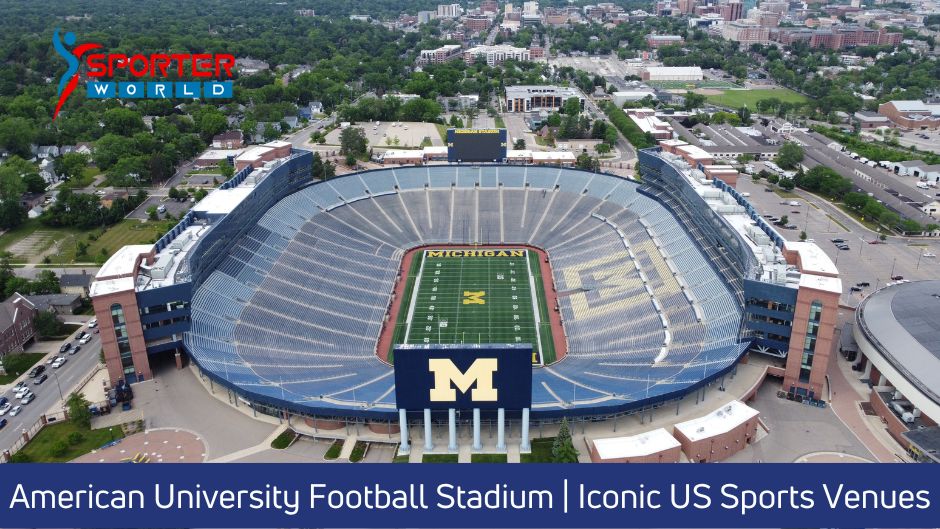Introduction
American University Football Stadium are some of the most iconic and popular sports venues in the United States. They are home to some of the country’s most storied college football programs and host some of the biggest games in the sport each year.
While there are a number of different types of American football stadiums, they all share a few common features. Most notably, they are all large structures that can accommodate tens of thousands of fans. They also typically have a playing field that is surrounded by seating for spectators.
Also Read : Italian Serie A Women’s Basketball | Europe’s Oldest League
In recent years, American football stadiums have undergone a number of changes. Some of these changes have been driven by advances in technology, while others have been necessitated by changes in the game itself. Nevertheless, they have all helped to make these venues even more impressive and enjoyable for both fans and players alike.
As we will see in the sections that follow, American football stadiums come in a variety of sizes and shapes. They are also located in a wide range of settings, from small towns to major cities. Regardless of their location or size, however, they all play an important role in the history and tradition of American football.
Also Read Oak Hill Academy Girls Basketball: Championships & Success
A Look at the History of American University Football Stadiums
American university football stadiums have a long and storied history. Some of the earliest stadiums were built in the late 19th century, such as Harvard Stadium, which opened in 1903. These early stadiums were often little more than large open fields with bleachers for spectators.
As the sport of football grew in popularity, so too did the size and scale of university football stadiums. By the 1920s, many universities had built large, multi-purpose stadiums that could seat tens of thousands of fans. These stadiums became the centerpieces of campus life, hosting not only football games but also track and field meets, concerts, and other events.
Today, university football stadiums are among the largest and most popular sports venues in the country. They are often iconic landmarks on campus and play host to some of the most passionate fans in all of sports. As the sport of college football continues to grow in popularity, it is likely that university football stadiums will continue to get larger and more sophisticated.
Also Read : Messi Premier League Joins : The Best Just Got Better
The Largest American University Football Stadiums
The United States is home to some of the largest football stadiums in the world. American universities have long been at the forefront of stadium design, with many of the largest and most popular stadiums belonging to colleges and universities.
The largest American university football stadium is Michigan Stadium, located on the campus of the University of Michigan in Ann Arbor, Michigan. The stadium has a capacity of 107,601 spectators and is one of the most iconic college football venues in the country.
Also Read : Arena Football League Standings: Factors & Importance
Second on the list is Beaver Stadium, located on the campus of Pennsylvania State University in State College, Pennsylvania. The stadium has a capacity of 106,572 spectators and is one of the most historic and tradition-rich stadiums in college football.
Rounding out the top three is Ohio Stadium, located on the campus of The Ohio State University in Columbus, Ohio. The stadium has a capacity of 102,239 spectators and is one of the most intimidating places to play in college football.
These three stadiums are not only the largest in America, but also some of the most popular and well-known college football stadiums in the country. They are all historic venues that have hosted some of the biggest games and most memorable moments in college football history.
Also Read Best Cricket league in the World 2023
The Most Popular American University Football Stadiums
There is no definitive answer when it comes to the most popular American university football stadiums. However, there are a few that stand out above the rest. The first is the Rose Bowl in Pasadena, California. This stadium has been home to some of the most iconic moments in college football history and continues to be one of the most sought-after tickets in the sport.
Another popular university football stadium is Michigan Stadium in Ann Arbor, Michigan. This stadium is not only one of the largest in the country, but also one of the loudest. The fans that pack into this stadium on game day create an electric atmosphere that is unmatched anywhere else in college football.
Also Read : La Liga Soccer Ball – Reliable & Durable Performance
Finally, Texas Memorial Stadium in Austin, Texas is another popular university football stadium. This stadium is known for its unique design and for being one of the hottest venues in college football. The heat and humidity can make for some very interesting games, which only add to the allure of this stadium.
These are just a few of the many popular university football stadiums across America. Each one has its own unique history and tradition that make it special in its own way.
Also Read : Alabama High School Football History: A Look Back
The Most Expensive University Football Stadiums
The most expensive American university football stadium is the Rose Bowl, located in Pasadena, California. The stadium cost $152 million to construct and opened in 1922. It is the home of the UCLA Bruins football team and has a capacity of 92,542.
The second most expensive American university football stadium is the Ohio Stadium, located in Columbus, Ohio. The stadium cost $126.6 million to construct and opened in 1922. It is the home of the Ohio State Buckeyes football team and has a capacity of 102,329.
The third most expensive American university football stadium is the Michigan Stadium, located in Ann Arbor, Michigan. The stadium cost $95 million to construct and opened in 1927. It is the home of the Michigan Wolverines football team and has a capacity of 107,601.
Also Read : Australian National Football Team Logo: History & Impact
The Future of American University Football
The future of American university football stadiums is shrouded in potential but fraught with uncertainty. The game of football is in a state of flux, with rule changes and new player safety initiatives constantly being implemented. This has led to some schools scaling back their programs or even dropping them altogether. At the same time, there is a growing movement among universities to build larger and more modern stadiums that can accommodate more fans and provide a more immersive game-day experience.
It remains to be seen how all of these factors will play out in the coming years. It is possible that we will see a decline in the number of university football programs, as well as a decrease in the average size of stadiums. However, it is also possible that the game will continue to grow in popularity, leading to even more expansive and expensive stadiums being built. Only time will tell what the future holds for American university football stadiums.
Also Read : “Badminton Life: Get Active, Have Fun, and Make Friends”
Conclusion
In conclusion, American university football stadiums have come a long way since their humble beginnings. Today, they are some of the largest and most popular stadiums in the world. They are also some of the most expensive to build and maintain. However, these costs are worth it to the universities and their fans, as they provide a unique and exciting experience that cannot be found anywhere else.



